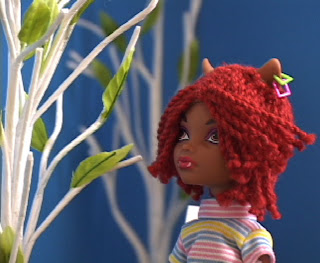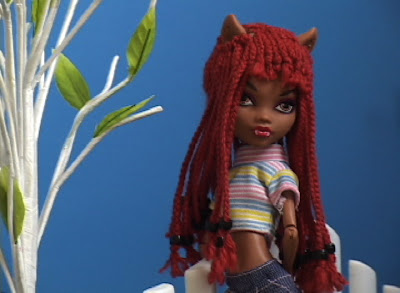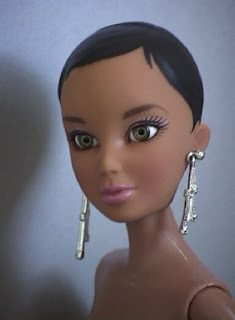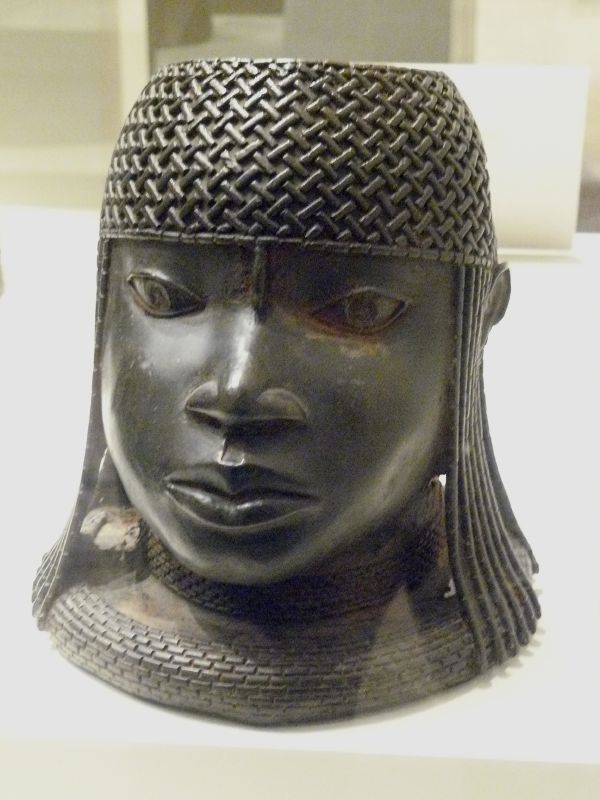Tuesday, May 31, 2011
Les Soeurs Garoul
When I was a child, our doll community had “monsters” – usually the result of botched efforts to modify a doll. It is precisely this type of modification that I feel is an essential element of child’s play. If children only re-enact scenes and characters they have seen on screen, they have less opportunity to develop imagination and creativity. So when I first saw the Monster High Dolls, I didn’t like them because they were pre-set characters tied to an animated series.
I also did not like the Monster High dolls’ over-sized heads and swaybacked, anorexic bodies. Yet Clawdeen Wolf was very cute struggling to free New Moon Jacob from his box on Ebony Nicole’s Brooklyn Stars Forever blog. And then I saw a picture of the green haired, Dawn of the Dance Clawdeen Wolf on Aneky’s Flickr stream. Suddenly I recognized the full power of social networking media as a marketing tool. I looked at Clawdeen Wolf with new eyes and I had to have her.
First I bought the original version of the doll because I liked her make-up the best. Once I got her home, the articulation of that spavined little body won me over. I stripped her naked and started making lacy lingerie for her. Within a week I had also purchased the Dawn of the Dance version. I bought the Gloom Beach version along with her because I didn’t like the painted on black gloves and I wanted to be able to swap out her hands. I rationalized that I would give my niece a customized version of the Gloom Beach doll with a motorcycle outfit that would match the gloves.
I must confess that I also watched the animated shorts on-line. I especially liked the idea of a character who experiences power surges rather than PMS every full moon. I thought there were some interesting possibilities in a woman who is a bonafide b****. So next I attacked the hair because after all, what really attracted me to Clawdeen Wolf is that by my reckoning she is a black doll. I wanted her hair to reflect a more Afro-centric aesthetic and I figured my niece might enjoy having a variety of different looks for her doll. (Of course I was still pretending that I was going to give the Gloom Beach doll away).
Kudos to Mattel for the quality of their product. I had so much trouble pulling Gloom Beach Clawdeen’s hair out that I gave up and cut it down to the roots with my sewing scissors. The ears were my next challenge. I wasn’t sure how I could make a wig cap that would accommodate them, but it wasn’t as hard as I had feared.
Another thing I had disliked about the Gloom Beach doll was the strange orange lipstick she was wearing, but oddly enough that shade really made the paprika yarn that looks terrible on almost all of my other dolls pop. So now I have a family of Cajun werewolves from Opelousas, Louisiana. Claudine and Claudia are glamour girls, but Claudette is more of a tomboy. I thought it would be easier for her to manage her hair if she stopped straightening it and tried some natural hairstyles:
Claudette is so hot with her hair au naturel that I think her sisters, Claudia, and Claudine might have to give up their fake-looking weaves too.
À Bientôt
Sunday, May 29, 2011
Franken-Liv

The Liv heads were starting to pile up around my house. I told myself I was going to list them for sale on eBay, but one day I looked more closely at one of the Alexis heads and decided I rather liked the face, just not on a 1:6 scale body. Next thing you know, I’m making wigs for her and wishing I could see how she would look with a body that was more in proportion to her head.
I was vaguely aware of the Moxie Teen dolls so I tucked one Alexis head in my purse and started trolling the toy aisles to see if any of the Moxie Teens would be a good complexion match. I struck out several times at my local Targets, which don’t seem to carry many Moxie Teens at all, but hit paydirt at Toys R Us where Melrose was actually a few dollars cheaper than her counterparts over at Target.
Body
The Moxie Teens series actually includes a doll with a chocolate complexion, Bijou, but if you look past the frowsy blonde wig MGA put on Melrose, you will see that Liv Alexis is a better match than the bug-eyed head that comes with this fully articulated body. I can’t throw too many stones since the Liv dolls also have glass eyes, but the eyes are more in proportion with the rest of the face and they don’t have the ridiculously exaggerated lashes that come on the Moxie Teens dolls.
A gentle tug readily dislodged the Melrose head. The Alexis head was a bit of a tight fit, but once it was in place, it was a perfect match.
The body is articulated at the ankles, knees, hips, wrists, elbows, shoulders, and neck.
The doll's waist does not twist but her torso is segmented just under the bust so she can affect a classic debutante slouch.
While the feet are flat like Liv’s, the high instep allows the doll to wear high heeled shoes – if you can find any in her size.
Melrose did come with a high heeled pair of biker boots that are slit up the back for easy removal.
Clothes
The boots perfectly complement a timeless teen ensemble – edgy black jacket, white cotton t-shirt, and straight legged, acid wash jeans that fit like they were spray painted on.
Fortunately the spandex blend in the fabric and the Velcro closure in the back make these jeans easy to put on and take off. Back in the day many of the “bad, bad misses” that the Ohio Players immortalized in a 1975 hit had to lie down and use a pair of pliers to get their skin tight britches zipped.
Accessories include a wide hip hugger belt, roomy shoulder bag, and matching big apple cap in sparkly simulated leather – all of which would have been considered stylish over thirty years ago when I was a teen. Plus ça change, plus c'est la même chose.
The outfit also includes plenty of bling – a sparkly silver bangle on the left wrist, a chunky silver ring and a black and silver bracelet on the right, and a dainty heart on a molded silver chain around the neck. Dangly silver earrings complete the ensemble.
Unfortunately the jewelry reflects the doll’s low price point as the necklace and one earring came apart when I tried to adjust them. I suspect that the doll’s joints may be equally fragile, but her poseability might make her attractive to those who enjoy staging high fashion photo shoots, but aren’t yet ready to plunge for Mel Odom's Violet or Robert Tonner's Esmé.
Since I prefer my own custom wig designs, I may still sell my growing collection of Liv and Moxie Teen wigs on eBay, but this Frankendolly is a keeper!
See my Flickr stream for more photos.
À Bientôt
Thursday, May 26, 2011
Wigging Out -- Locks
“You mean those folks have a name? I thought they were just chinchy Negroes that didn’t comb their hair.” – Cousin Esther circa 1984
My Cousin Esther invited me to spend the summer after my first year in graduate school with her in Chicago.
I took advantage of the opportunity to study dance at the Gus Giordano School in Evanston, and I absorbed a lot of womanly wisdom from my cousin who was then in her early seventies. Cousin Esther had never heard of Rastafarians before, but when I gave her a copy of Bob Marley’s Kaya as a thank you, she discovered she loved reggae music!
Fast forward about twenty years. I was seeing brothers and sisters wearing twists all over New Orleans so I started making twist style wigs for my dolls. Then, as so often happens, the dolls influenced me. I washed my hair one Sunday afternoon and decided to try styling my own hair in twists.
In Hair Story: Untangling the Roots of Black Hair in America, Ayana D. Byrd and Lori L. Tharps explain that in traditional African societies, “communication from the gods and spirits was thought to pass through the hair to get to the soul” because “the hair is the closest thing to the heavens” (4). I wore my hair in this twist style inspired by Oya, mistress of the whirlwinds, for most of the summer of 2005. Little did I know she was “riding my head” because she and Yemaya (mistress of the sea) were cooking up a little surprise party for August 29th!
In honor of all the natty dreads who showed us how to appreciate the natural textures of black hair, here is a selection of dreadlock hairstyle wigs I have developed for 1:6 scale dolls and action figures:
My Cousin Esther invited me to spend the summer after my first year in graduate school with her in Chicago.
I took advantage of the opportunity to study dance at the Gus Giordano School in Evanston, and I absorbed a lot of womanly wisdom from my cousin who was then in her early seventies. Cousin Esther had never heard of Rastafarians before, but when I gave her a copy of Bob Marley’s Kaya as a thank you, she discovered she loved reggae music!
Fast forward about twenty years. I was seeing brothers and sisters wearing twists all over New Orleans so I started making twist style wigs for my dolls. Then, as so often happens, the dolls influenced me. I washed my hair one Sunday afternoon and decided to try styling my own hair in twists.
In Hair Story: Untangling the Roots of Black Hair in America, Ayana D. Byrd and Lori L. Tharps explain that in traditional African societies, “communication from the gods and spirits was thought to pass through the hair to get to the soul” because “the hair is the closest thing to the heavens” (4). I wore my hair in this twist style inspired by Oya, mistress of the whirlwinds, for most of the summer of 2005. Little did I know she was “riding my head” because she and Yemaya (mistress of the sea) were cooking up a little surprise party for August 29th!
In honor of all the natty dreads who showed us how to appreciate the natural textures of black hair, here is a selection of dreadlock hairstyle wigs I have developed for 1:6 scale dolls and action figures:
 |
| Short locks -- paprika |
 |
| Wavy locks -- mustard streak |
 |
| Long locks -- auburn streak |
 |
| Updo locks -- brown |
Please let me know what styles and colors are your favorites and what you would be willing to pay for handcrafted items that take up to six hours a piece to produce.
À Bientôt
Tuesday, May 24, 2011
Wigging Out -- Braids
"Glendora"
They’ve given Aunt Jemimaa new headrag
synthetic fiber curls
to replace bright calico…
Like the hopeful young women of “Dreamgirls,” the women in my mother’s family swore by their wigs. Usually the wigs covered their short plaits, but every now and then someone’s wig would slip and one of those little pig tails would peek out – to the wig wearer’s everlasting embarrassment.
This was my mother’s “go to” wig. She called it “Glendora.” I borrowed it for a photo shoot when I was in college:
The women in m mother’s family knew how to make cornrows, but they considered such styles “countrified” so it was the young men of my era who reclaimed braided hairstyles as a fashion statement. At first they would go to our cousin, Mary Jane, to get their hair plaited so their Afro’s would blow out to more impressive dimensions when they got ready to go to a dance. Later, under the influence of Stevie Wonder, they fell into the habit of wearing braids as a regular hairstyle instead of just as part of the upkeep on their ‘fros.
Braided hairstyles were one manifestation of the highly developed traditions of sculptural arts in African societies. Cicely Tyson was one of the first African American women to adopt braids as a fashion statement when she appeared on the CBS drama series, East Side, West Side with her hair in cornrows in 1962. In the doll world, Bryon Lars created extravagant sculptural braids for Moja, Tano, and Tatu from his Treasures of Africa collection while doll couturière Em’lia has crowned her “Comet Moth,” the 4th doll in her Insectopia collection, with braided horns.
My braided wig designs are much simpler, but here is a selection of the styles I have developed for 1:6 scale dolls and action figures:
 |
| Updo braids -- Expresso |
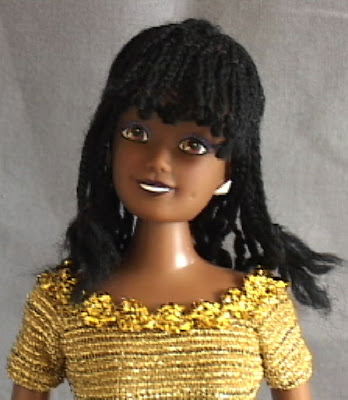 |
| Mircro-braids -- Black |
 |
| Center part braids -- Auburn |
 |
| Center part braids -- Chocolate |
 |
| Center bead braids -- Brick |
Please let me know what styles and colors are your favorites and what you would be willing to pay for handcrafted items that take up to six hours a piece to produce.
À Bientôt
Sunday, May 22, 2011
Wigging Out -- Afros
"Do you feel as if the toy selection in stores can affect the way a child looks at the world (consciously or unconsciously)? If so, how? Do you think that it is important for children to have access to dolls that represent their race or ethnicity? Why or why not?" Baby Beatriz Doll Project survey.
“Tu as des cheveux comme une princesse,” said my Haitian neighbors’ daughter, comparing my wavy, shoulder-length hair to the black mermaid doll I had just given her.
 By her fourth birthday Aya obviously did not feel her own hair measured up to princess standards, and unfortunately, by the time she is old enough to appreciate Limbé, Leon G. Damas’ 1937 poetic reflection on black identity, she will have already internalized the idea that there are no princesses with kinky hair.
By her fourth birthday Aya obviously did not feel her own hair measured up to princess standards, and unfortunately, by the time she is old enough to appreciate Limbé, Leon G. Damas’ 1937 poetic reflection on black identity, she will have already internalized the idea that there are no princesses with kinky hair. For the first day of school when I entered 3rd grade (which would have been in 1970), I wore my hair in an Afro. I had to keep my hair rolled up on kid curlers (remember those?) all day and all night, but when my mother picked out my hair that morning before school. I felt as fly as a Soul Train dancer and as foxy as an Afro Sheen model. A whole day of little white boys chasing me and calling me “bush baby” burst my bubble, and I never wore an Afro again. It wasn’t until the 1980s when I saw people paying serious money for Jheri Curl perms that I felt confident enough to let my hair “do its thing.” The sad part is, I had what most blacks, many whites, and the Puerto Rican stylist who gave me this cute cut considered “good” hair:
I just never felt my hair was “good enough” because it never grew long enough for me to sit on like my grandmother’s hair.
The images and cultural artifacts like toys that children are exposed to in popular media definitely influence the way they see the world and themselves. I do not have children myself, but I have always kept a box of fashion dolls for my friends’ children to play with when they visit. It breaks my heart to see beautiful little black girls digging through the box to find the doll with the lightest skin and the longest hair. In fact, this upset me so much, I started customizing fashion dolls with afros, braids, dreadlocks, and natural hair textures several years ago. Hurricane Katrina and a number of other life changes kept me from following through on my plans to market these products until now, but Vanessa Morrison’s post on Rohan, the D.J. from New Orleans has pushed me into unveiling my wig collection earlier than I had planned.
In honor of Odetta, folksinger and Civil Rights activist who was one of the first prominent African American women to adopt the “Afro” hairstyle, here is a selection of Afro hairstyle wigs I have developed for 1:6 scale dolls and action figures:
 |
| Vertical braid Afro -- chocolate |
 | ||||
| Afro -- honey blonde |
 |
| Horizontal braid Afro -- brown |
 |
| Wavy locks Afro -- toffee |
Please let me know what styles and colors are your favorites and what you would be willing to pay for handcrafted items that take up to six hours a piece to produce. And in case you aren’t familiar with Odetta, here is a clip of her singing a traditional African American lullaby, “All the Pretty Little Horses” in 1957:
À Bientôt
Friday, May 20, 2011
My First Doll Show part 7
“Long before a doll stood before you, the ancestors chose the doll’s artist and endowed her or him with the magical power to create.” (Whiteman 6)
“… he saw the sculpture her back had become, like the decorative work of an ironsmith too passionate for display…” (Toni Morrison. Beloved. New York: Alfred A. Knopf, 1987 p. 17)
In her introduction to Nayda Rondon’s Black Dolls: Proud, Bold & Beautiful, Barbara A. Whiteman, founder and executive director of the Philadelphia Doll Museum asserts that contemporary doll artists are creating figurative sculptures rather than toys:
The doll artists communicate ideas that are brought to life in the form of a doll. With a doll, our visual and tactile responses are so strong that we want to touch it, feel it to see if it is real. So often we say that the doll ‘looks like’ someone we know, or that it is so haunting. Artistically, likeness, meaning physiognomy, is often regarded as the most significant single element of portraiture, particularly Western art. The face or portrait, representational in form and naturalistic in style, is what we cherish most in dolls. When we look into a doll’s face, we establish the psychological connection with the doll. (7)The doll artists featured in this book strive to achieve realistic likenesses of black figures. Among those who would be most familiar to collectors of fashion dolls are Audrey Bell and Georgette Taylor, creators of Big Beautiful Dolls, Mel Odom and Michael Evert, creators of Gene’s African American friend, Violet, and Robert Tonner, creator of Esmé. In contrast, most of the doll artists I met at the Atlanta Doll Collectors' annual doll show on May 7th were using a more stylized, Afro-centric aesthetic to express aspects of African diasporan experience. Yet for me, Cassandra Harrison’s faceless dolls established the most powerful psychological connection. The figure below made me see my mother as a young woman full of hope and touched me so profoundly that I had to come back later after I had composed myself to conduct an interview with Harrison.
I AM Tanesha
I am the first person in m family to go to college
So I pray
I am Somebody
Whiteman states that “With each order to bring a doll to life, its artist must give up pieces of herself – not only her imagination, but her emotions and energies, until the image penetrates her soul and takes form. Then – and only then – does the doll present itself.” (Whiteman 6). Cassandra Harrison has literally invested pieces of herself in order to communicate the ideas she brings to life in the form of her dolls.
***
“I cut my hair and needed something to do with the locks…”
***
“I cut my hair and needed something to do with the locks…”
IAM-Dolls – Cassandra Harrison
harrisoncassandr@bellsouth.net
IAM-Dolls.com
404-284-2094
Cassandra Harrison has been making dolls for less than a year, but her one of a kind characters can move you to tears. After a thirty year career in fashion design, Harrison says “This is my legacy. Everything I’ve been in life has been preparing me for this.” Harrison kept the six dolls that she made from her own hair for herself, then started using recycled weave hair for new characters. Indeed, all the materials except the batting she uses to stuff the dolls are recycled. She even asked her women friends to donate their orphaned earrings so each doll wears only one earring.
Harrison has no idea how long it takes to complete a doll. She always has two or three in process and doesn’t know what they will be until they are finished. Indeed, Whiteman likens the process of doll-making to a birth -- “From the first day of conception, a doll struggles for its own identity. It has its own personality and requires a certain style, fabric and color to authenticate its existence (6).”
Harrison knows the doll is complete when it expresses the I AM – the God within each of us.
For more images of Harrison's work, view my Flickr Stream.
This post concludes the series about my first doll show, but I'm off to another doll show tomorrow. Who knows what treasures I will find!
À Bientôt
Wednesday, May 18, 2011
My First Doll Show part 6
“The Negro physiognomy must be freshly and objectively conceived on its own patterns if it is ever to be seriously and importantly interpreted. Art must discover and reveal the beauty which prejudice and caricature have overlaid. And all vital art discovers beauty and opens our eyes to that which previously we could not see.” (Locke, Alain ed. The New Negro, New York: Touchstone, 1997. p. 264)
In 1925, Alain Locke urged African American artists to find inspiration in “The Legacy of Ancestral Arts” by looking to Africa as “one of the great fountain sources of decoration and design (The New Negro 254).”
(photo by Trish Mayo)
Locke argued that the experience of slavery had disconnected African Americans from the aesthetic values that produced African masterpieces such as the bronzes of Benin (see the 16th century head of an Oba from the Metropolitan Art Museum collection above) and he asserted that “…what the Negro artist of to-day has most to gain from the arts of the forefathers is perhaps not cultural inspiration or technical innovations, but the lesson of a classic background, the lesson of discipline, of style, of technical control pushed to the limits of technical mastery. A more highly stylized art does not exist than the African (256)."
Locke noted the profound influence of African art on the development of modernist sensibility in Western art and heralded the dawning of an art movement among young African American artists such as Aaron Douglas at a time when few African Americans had the means to travel to Africa or to museums in Europe where collections of African art works were available for study.
Today the influence of African art is undeniable. The Harlem Renaissance and the Black Arts movement a generation later have re-connected African Americans to their aesthetic roots in Africa, and affordable “Africanesque” if not authentically African pieces are readily available in the home décor departments of major retailers. Furthermore, a significant number of the doll artists I met at the Atlanta Doll Collectors’ annual doll show on May 7th started as quilters. Quilting is one of the American decorative arts in which a continuous carry-over of visual rhythms from traditional African motifs persists. Thus, when quilters turn their design eye to three dimensional figurative pieces, they draw on both consciously chosen and ancestral links with African art.
While Mattie Eley’s “people” evoke smiles of recognition as portraits of character types, the stylization of the forms and her imaginative use of decorative motifs are firmly rooted in “The Legacy of Ancestral Arts.” Collecting art dolls like these enables the collector to express his or her own connection to “ancestral arts.” For, as David C. Driskell, curator of the collection of Camille O. and William H. Cosby, Jr. collection states in The Other Side of Color “an art collection serves its owner beyond the function of its visual impact. It provides a cultural context that describes the creative impulse held by collectors. (3).”
***
“That’s all the mama and them’s right there” – visitor comment
Mattie’s People – Mattie H. Eley
404-373-2993
mateley@bellsouth.net
www.mattiespeople.com
The first thing people tend to do when they get a new doll is look up her dress, so Mattie Eley learned very quickly to put undergarments on all her creations. She had been sewing since she was nine years old, so she started making dolls as Christmas presents for her nieces and grandchildren when she was looking for something to do after her retirement almost four years ago. In her new career as a doll artist, Eley has become an avid people watcher. She pays special attention to attire and hairdos and translates the attitudes she observes all around her into her dolls’ needle sculpted faces. “The dolls got me, I don’t got them” she says of the 20-40 hour process that may start from a piece of fabric that intrigues her. “I don’t know where I’m going from there” she adds, but the result are profoundly satisfying when someone walks by her booth and says “Oh, that’s my cousin!”
À Bientôt
Subscribe to:
Posts (Atom)







